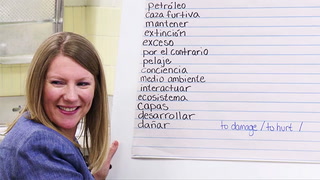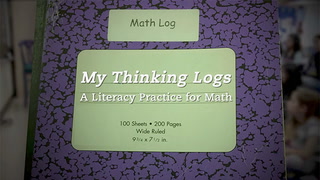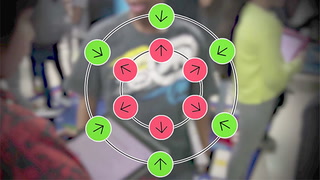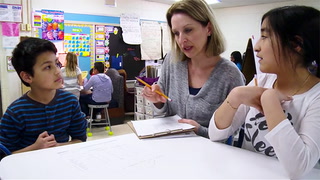Bridging Content in a Bilingual Classroom Transcript
Jessica: Alright, everybody here? Okay.
My name is Jessica Hague, and I teach fifth grade duo-language at Banting Elementary in Waukesha, Wisconsin. I work in a combined classroom with Chris [inaudible 00:00:20] and we co-teach together.
Determine if there are any more words that we need to add to our list before we get started, okay?
Speaker 2: Atmosphere.
Isaiah: [inaudible 00:00:27]
Speaker 2: Fertilizers.
Jessica: This unit was a science unit. The title of it was 'The Environment' and our essential question was, 'How do human beings affect our environment?' The whole unit was taught in Spanish. Today's lesson is at the very end of it where we've bridged over now to English.
[00:00:46] (Speaking Spanish )
We began trans-languaging the Spanish written summaries that we did earlier in the week.
What are we gonna do today? Cruz?
Cruz: Translate.
Jessica: We're gonna trans-language, right?
Cruz: Right.
Jessica: We have taught the kids to use the word trans-language instead of translate because really it's more than just word for word. It's reflecting the meaning in the other language with all of their differences and caveats that they have between the two languages.
Yesterday we determined that these were some very important words that we need to know how to say in English.
So, really the language objective was for the kids to be able to explain and discuss with their bilingual partners, the concepts from the science unit in English after bridging.
Alright you guys, give it to me. Alex?
[00:01:32]
Alex:
(Speaking Spanish )
Jessica: Wait, replace, [inaudible 00:01:36]. To replace. So, in Spanish our verbs in the infinitive form always end in R, and when the verb is ending in the R we have to make sure that we put 'to replace'. Josh?
Josh: [inaudible 00:01:51], to damage.
Jessica: Good. What is another way? Addie?
Addie: [inaudible 00:01:55], to hurt.
Jessica: Yes, exactly. One more way. [inaudible 00:01:58]?
Speaker 8: To harm?
Jessica: Yes. So you have a lot of options when you are thinking about how you're going to write that in English.
As soon as we have all of the words written in English, the kids had an opportunity to discuss with each other and identify which words were cognates.
Speaker 2: I think fertilizer is.
Speaker 9: [inaudible 00:02:22] and legally, the only thing that's different is the 'ly' and here it's the [inaudible 00:02:28].
Speaker 10: No, because when I think about [inaudible 00:02:34] I think of [inaudible 00:02:39], like, fabrics.
Speaker 9: [inaudible 00:02:40] Yeah, and I found, you see that, pesticides. [inaudible 00:02:48] I put that one up here.
Jessica: [inaudible 00:02:53], factories.
We identified 14 cognates and we had a few of those that were controversial.
How many of you think that's a cognate? How many of you think no?
Speaker 11: Mrs Hague can I add something?
Jessica: Yeah, absolutely.
Speaker 11: So, raise your hand if you were in my group yesterday, 'cause we came with this word, didn't we? When we were trying to find the word, did most of you know what the translation was? We had to look it up, didn't we? So what does that tell you? Cognate or non-cognate?
Jessica: Oh, thanks for [inaudible 00:03:27], we didn't have that in our LEA yesterday so that's good.
It's such a benefit to co-teach with Chris [inaudible 00:03:33] because we almost model on an hour-by-hour basis the comradery and the way that adults successfully work with each other, and it's not just a job in isolation.
[inaudible 00:03:43], positively. Mm-hmm (affirmative). What do you have to understand in order to be certain that this is a cognate? Lauren can you share what you were talking about?
Lauren: Well, I think that it's a cognate because if you know that in Spanish, that [inaudible 00:03:56], that if a word ends in 'mente' in Spanish, in English it would end with an 'ly'.
Jessica: What kind of words are those, that in Spanish end in 'mente' and in English end in an 'ly'? What do we call those kinds of words? Tyler?
Tyler: I think adverbs?
Jessica: Exactly. Those are adverbs, okay? So, if we understand that about the differences in our two languages, then we can say that that's a cognate, right? Good.
After that they had a chunk of time to be able to work with their bilingual partners and begin trans-languaging the Spanish written summaries that we did earlier in the week.
[00:04:40]
Speaker 14:
(Spanish speaking )
Jessica: They had a good 15-20 minutes to work with each other and discuss misunderstandings or things that just didn't sound right to them.
Where are you going to be writing your trans-languaging? Elizabeth?
Elizabeth: Google Docs.
Jessica: Google Docs. You need to share it with your bilingual partner so that you both can work on it together.
Speaker 16: I got the [inaudible 00:05:02] thing.
Jessica: When I intentionally pair students I use bilingual partners. We usually put a native English speaking student together with a Spanish speaking student so that they can share their strengths in order to achieve the language part of content.
Speaker 17: You could put the translator thing he did.
Jessica: We are very fortunate in Waukesha to be one-to-one, which means that every student in our district has a school iPad, if they needed to look up on Google Translate, or if they needed to talk with a partner, 'How do you say this word in English?' They have a chance to share their thoughts.
Speaker 18: [inaudible 00:05:38] no.
Jessica: If you have a doubt, what can you do?
Speaker 18: [inaudible 00:05:43]. Different ecosystem.
Speaker 19: Ecosystems.
Speaker 18: By the [inaudible 00:05:53].
Speaker 19: Negative.
Jessica: You're almost there. So what are we trying to say? We're trying to say?
Speaker 19: The effect of different ecosystems. Negativity because [inaudible 00:06:10]
Jessica: Because of?
Speaker 19: Contamination?
Jessica: Write it down.
Speaker 19: Read the whole sentence.
Speaker 18: We have learned much through our investigation that human beings can affect negatively a different ecosystem.
Speaker 19: Affects in a negative way.
Speaker 20: How the human being negatively affects.
Speaker 19: Oh, yeah.
Jessica: It negatively affects different ecosystems. Okay. How? How do they negatively affect the different ecosystems? There's a word that's really important in that first sentence. They're giving you kind of an example in that first sentence.
Speaker 19: Contamination?
Jessica: How do we ... Contamination or?
Speaker 19: Pollution?
Jessica: Yeah.
Speaker 19: Because of pollution?
Jessica: Yeah. Mm-hmm (affirmative). So, that's a really important idea that comes out of that first sentence.
As they were working with their bilingual partners I had a chance to walk around and talk with some of the pairs.
We shaft from transportation? Tell me where ... Was that just a typing error? Tell me, can you explain that?
Some of them wanted to translate things word for word but when they did that, they realized that some of the things that they were putting down in English just didn't make sense.
[inaudible 00:07:28]? Now, is that word on our bridge list?
Speaker 21: No. Actually, was it?
Speaker 22: Yeah, yeah.
Speaker 21: I'm not sure it was.
Speaker 22: It is.
Jessica: It's right there. So, you have your tools all right there.
Speaker 22: Negatively affected by ...
Speaker 21: Other ecosystems?
Speaker 22: Ecosystems. Oh, besides is a good one.
Speaker 21: That's actually a really good one.
Speaker 22: [inaudible 00:08:02], no, wait.
Speaker 21: In addition to?
Speaker 22: Oh, yeah.
Speaker 21: No, maybe, maybe ...
Speaker 22: In addition?
Speaker 21: In addition. We've got to throw out the kind of sounds, like ...
Jessica: But, so now put in throughout and see, that's a different word, isn't it?
There's a lot of great conversations that happened around the differences in the languages, but it took a little bit longer than we had planned for today.
Speaker 23: [inaudible 00:08:26].
Jessica: So could I put [inaudible 00:08:28]? [Speaking Spanish 00:08:32].
Speaker 23: No.
Jessica: No, right?
Speaker 23: So, it's through.
Jessica: So, let's fix that in your first sentence and see if then it sounds a little bit better.
Speaker 23: We've learned through our investigations.
Speaker 24: And keeps affecting the forest. The forest, and the jungles.
Jessica: I know that you're not done, but we're gonna share what we have gotten done so far, and then you'll have time this afternoon to finish it up. Okay, so everybody stand up. You're gonna get ready to do your parallel lines.
Then, we went into a strategy called parallel lines where we split the group into two.
The people who are on the outside, find someone that wasn't your partner and stand in front of them. Not only are you sharing your work but you're also listening very carefully to the way that they did their trans-languaging and you're going to give your partner a glow and a [inaudible 00:09:35]. Ready? Go. [crosstalk 00:09:40]
That really gives us an opportunity for kids to have multiple opportunities to share and hear the work that they're doing.
Speaker 24: I think it would sound better if you switched human beings and needs and wants.
Speaker 2: Okay. I really liked how you said it in the order. I think that was one of your glows.
Jessica: Who would like to share something that was challenging for them? Isaiah?
Isaiah: I got stuck on the part when it was talking about, like, they take away animals' homes.
Jessica: Right where the pink is?
One student shared his work asking for help because he was struggling with how to translate one of the sentences, and so we worked together as a team of the whole class to help him translate that into English.
Turn and talk to your partner. Think about what would be the best way for him to say that sentence. [crosstalk 00:10:36].
The best thing about teaching at Banting is being able to see the way that students work with each other.
Alex: Another way that humans affect the animals that live in the jungle.
Jessica: Another way?
The kids get a chance to display their talents because we flip flop back and forth between math and English and Spanish, so they really create an equal playing field.
Show me in the Spanish version where you got the word [inaudible 00:11:05], from? Did you just want to throw a little flair in there?
Alex: Yeah.
Jessica: Yeah.
















28 Comments
LaBresha Small Mar 14, 2024 12:16pm
Ms. Hegg teaches her students to use the word "translanguage" instead of "translate” because she said, it's more than just word for word. It helps them to reflect the meaning in the other language. All the students have differences they have between the two languages.
Ms. Hegg intentionally pair her students as bilingual partners. She puts a native English-speaking student together with a Spanish speaking student.
Technology supports the students in their work because they have their own device and are able to utilize Google translator.
If my classroom did not have access to tech tools I could adapt parts of this lesson by simply looking for cognates and discussing them as a whole group with anchor chart as Ms. Hegg demonstrated. I could also preplan to have visual aids and examples of some of the vocabulary handy. Lastly, using each student’s strengths to be a help to their partner as I go around and model, observe and confer.
Joann Miller Mar 9, 2024 8:32am
I liked the way Mrs. Heggs paired the kids, so they could help each other. They were able to work in pairs to give each other ideas to figure out the words. Their use of techology, working in pairs worked great for this lesson.
Malia Tuiasosopo Sep 25, 2022 3:07pm
1) Ms. Hegg utilizes the term translanguage to place emphasis on the meaning of words and wants her students to focus on building language comprehension.
2) She paired her students in groups that would benefit both types of language speakers. She placed spanish speakers with english speakers so they can assist each other and create a bond/connection.
3) Technology can assist with all aspects of the bilingual classroom. Students are able to use tech to perform research, share work/ideas, and use translation tools if necessary. Students have access to bilingual texts and thesauruses.
4) I can overcome technological challenges by utilizing a variety of visual aides. Reverting back to textbooks, posters, charts, and magazines. Keeping a manual translation book/dictionary on hand would be beneficial as well.
Kristine Lopez Sep 16, 2022 2:37pm
2. MS. Heggs paired her students with an English speaking with a Spanish speaking to give a better understanding of each other's strengths to achieve the language part of the content.
3. Technology will help them research what hey need for the assignment.
4. I would use books.